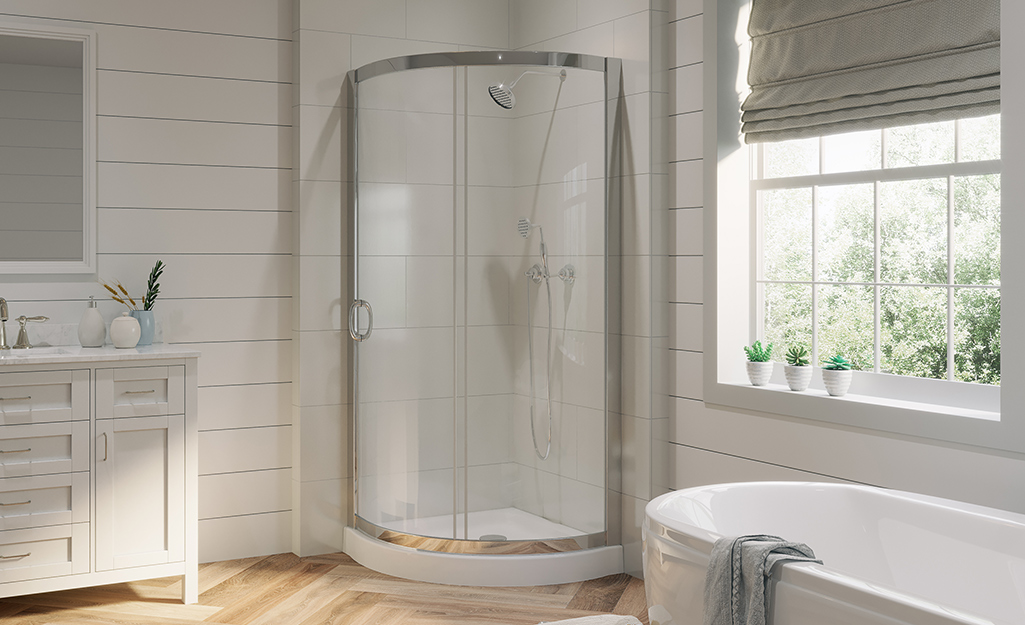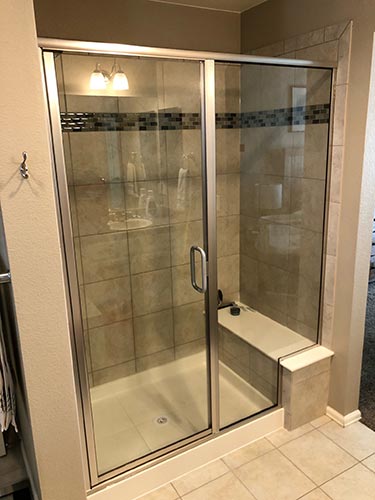This post which follows relating to How to Install a Shower Enclosure is seriously remarkable. Don't skip it.

A successful shower installation calls for mindful preparation as well as a great deal of work. In many cases, you will require to do 3 kinds of tasks: mounting wall surfaces, setting up the plumbing, and finishing wall surfaces.
Different Types of Shower Units
- Push-on Mixer: The hose and also spray parts of the push-on mixer shower system can be connected to the bathroom faucet as per your requirement, and the water temperature can be adjusted using the taps. Push-on mixers are cheap and exceptionally straightforward to set up. However, although the hose link is basic, it is quickly dislodged. Furthermore, it is troublesome to adjust the temperature level.
- Bath/Shower Mixer: The pipe as well as spray of this type of shower are incorporated with a bathroom mixer tap, and also the temperature level can be adjusted via the bathroom taps. It is a really affordable option and also no additional plumbing is involved. Nonetheless, the bath/shower mixers likewise suffer from bothersome temperature level control options.
- Guidebook Mixer: The pipe and also spray of a hands-on mixer shower device belong of the wall device as well as the hot and cold water products are linked to a solitary valve The temperature level and stress of the water are managed through either one or a selection of knobs (in a lot more expensive showers). Although temperature control is a lot easier in hands-on mixer kinds, they are a lot more expensive than the formerly mentioned mixers. They additionally require added plumbing of hot and cold water pipes.
- Thermostatic Mixer: The pipe and spray of this shower kind belong of the wall device as well as the cold and hot water supplies are attached to a single shutoff here as well. It is complete with an integrated stabiliser to self-adjust the water temperature level and to avoid it from coming to be as well warm. One of the greatest benefits of a thermostatic mixer shower kind includes hassle-free temperature level control. Nonetheless, it is the most costly of the various mixer options.
- Power Shower: A power shower is a solitary device including an effective electrical pump that is capable of changing both the water pressure and also temperature. This kind of shower can be fitted if there is water from a cold water cistern as well as a warm water cyndrical tube. A power shower makes the adjustment of both stress and also temperature simple. On the other hand, it disagrees for water warmed directly by the shower or where the water is supplied by a mix central heating boiler under mains pressure.
- Electric Shower: An electrical shower is plumbed right into a keys cold water supply and also it heats the water electrically. It is essential to keep in mind that for this shower kind to be installed, the mains pressure requires to be at least 0.7 kg/sq cm (10lb/sq in). The system permits the temperature level and pressure to be changed by means of a handle. Models with temperature stabilisers are better as they remain unaffected by other taps elsewhere in use within the house. A significant downside of electrical showers is that the control handle just permits the alternative of high temperatures at less pressure, or lower temperatures at a better pressure. This is troublesome in the winter season when the spray is typically weak and the mains water is colder. However, this trouble is taken on in some versions which are readily available with a winter/summer setup.
A Lot Of Typical Errors
- Breaking or disregarding neighborhood code constraints.
- Making use of pipelines that are as well small.
- Attaching copper to galvanized without using a brass or dielectric fitting between the two.
- Not using tape or pipe substance at threaded joints.
- Uneven your components when mounting them.
- Not mounting an air space filling up for fixtures.
- Cutting supply stub outs too short to mount the shutoff valves onto after the ended up wall remains in location.
- Not correctly aligning tubes right into fittings or stop shutoffs. (Requiring the nut onto the compression ring at an angle when the tubing goes to an angle will certainly cause a leakage.).
- When transforming the water back on in your home, always run the outdoors pipe valve or purge your bathrooms to bleed dust as well as air from the lines. This debris can create problems in your sink taps as well as other plumbing trim.
Preparation.
To start with, you have to select the kind of shower that you wish to mount. It is very important to establish whether the chosen shower can handling specific systems and also can control a safe level of water via the boiler. Most shower units nowadays are made to be flexible to various water pressures (such as saved hot water and also cold mains).
It is likewise important to think about the water pressure and also the planning of the piping and also drainage for the shower.
Approach.
Depending on the sort of shower you wish to mount, the shower head must either be fitted in order to prevent its contact with the water in the bath listed below or the base tray, or it should have a check shutoff.
Before beginning, it is a good idea to mark the settings of the shower head and control, and also to plan the pipe-work entailed. Additionally, the water drainage system to remove the drainage will require to be planned. Both placements of the cable path and also the shower switch will certainly also require to be considered if an immediate or electric shower system is being mounted.
Utilize the guideline guide supplied with the shower unit to fit the shower control.Before fitting the pipelines that will supply the water to the shower system, it is very important to cut off the water system. In order to shield the pipes, they must be given a water resistant covering as well as also fitted with separating shutoffs. The pipes can then be hidden into the wall and also plastered over to neaten the general appearance.
Fit the base tray, shower head, and also installations.
Connect the primary shower control to the pipes that will certainly be providing the water (This might require a female screw thread adapter).
Reconnect the water system and also examination the pipelines for any kind of leakages, as some might need tightening.
If you are setting up an electrical shower, keep in mind to turn off the power supply before making any electrical connections. When these connections have actually been made (there must be advice within the user's manual), the power supply can be switched back on.
Adjusting Water Stress to Fit Your Shower.
The cold water tank can be raised to a better elevation (occasionally as little as 150mm (6inches)) by fitting a strong wooden support beneath it - possibly made up of struts and blockboards. If you choose this alternative, the major and also circulation pipelines will certainly likewise need to be elevated to meet the new height of the reservoir.
Conversely, a booster pump (a solitary pump or a dual/twin pump) can be fitted. Whichever type is chosen, it has to be attached right into the power supply in order to operate.
Piping and Water drainage.
It is best to make use of 15mm diameter supply pipelines, and also make the go to the shower as brief as well as straight as possible so as to preserve maximum pressure and minimise warmth loss. In addition, by reducing making use of elbows for pipe corners, you can decrease the resistance in the flow of the water supply. You can attain this by flexing the pipes instead.
How Do You Install a Shower? Follow This Guide
Installing a Shower at a Glance
- Tools & Materials: Level, electric drill, caulk, hole saw, cedar shims, shower unit
- Step 1: Drill pilot holes
- Step 2: Prep fixture holes
- Step 3: Move unit into place
- Step 4: Caulk corners and base
- Step 5: Attach door
- Step 6: Install shower pan
Whenever plumbing is involved in a DIY project, people worry about what might go wrong. The truth is that installing a shower isn’t that complicated, and you can save a lot of money by doing it yourself. You shouldn’t need to make any alterations to your plumbing to complete the job, and most of the tools you need will be provided in your new shower kit.
Can I Install a Shower Myself?
Even if you’ve never installed a shower before, you’ll find this to be a project that is perfectly suited for DIYers with a moderate level of experience. Whether you're doing a bathtub conversion or installing a new stall, most of what you need comes in shower kits that you can purchase from a hardware store. The first thing you need to do is determine what type of shower stall you want.
Single-panel stalls are the easiest to install because they come preassembled. All you need to do is put them in place. Multi-panel showers require a few additional steps, but you’ve got more control over the appearance of your unit. Multi-panel units are also much easier to handle if you’re going to do the installation without any help.
Be sure to take all appropriate safety precautions, such as wearing eye protection and gloves. When you’re removing or installing a shower unit, you might kick up debris that could hurt your eyes. You’ll also need to work with equipment that will get extremely hot, so be sure to have safety gloves handy.
Tools and Materials
- 2- to 4-foot level
- Electric drill with a 1/8-inch drill bit
- Caulk
- 2-inch hole saw
- Cedar shims
- The unit itself
Before You Begin: Prep the Space
It’s highly important to measure your space accurately before putting the stall in. Measuring from the floor upward and from each corner outward will ensure you’ve got the right measurements. What you’re looking for is where the plumbing apparatuses are going to come through the stall. Transfer these measurements over to the back of your unit by drawing the locations of these holes using a pencil or marker.
Pull out your old shower and make sure to scrape off all the old caulking. Be thorough because you want to work with smooth surfaces for the best installation. Once you’ve pulled out your existing shower, you need to make sure that the floor is clean and dry. The best way to clean debris is with a shop vacuum, as it’ll soak up water and dirt together.
If you’re experiencing any plumbing issues, such as low water pressure, this is a perfect opportunity to solve them. Make sure that the pipes themselves are not in need of patching and clean your showerhead. When you turn the water back on after your project, check the pipes for signs of wear or disrepair. Anything beyond minor repairs should be handled by a plumber, and this is the best time to bring in a professional.
If the floor has any moisture at all, don’t proceed until it’s completely dry. The last thing you need is for the floor to rot or invite mold and mildew into your base. Once everything is dry, apply waterproof wallboard to the walls. This can be attached with screws or nails, then sealed with caulk so that water doesn’t seep into any crevices.

I discovered that post on How to Build a Shower Enclosure for Your DIY Bathroom while doing a search on the search engines. Sharing is nice. Helping people is fun. Thank you so much for going through it.
Schedule A Free Estimate
Comments on “Demystifying Shower Unit Installation - Everything You Need To Know”